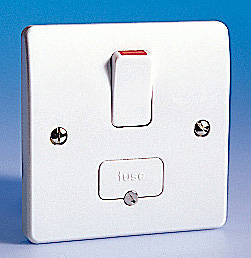I think the only thing that is expected to be connected to a fused spur without notifying is some socket outlets. That's why the two are mentioned so closely together.
How about a fused spur to feed lights? The link between the fused spur and the lights isn't
quite so close then, because they're separated by the "or" conjunction between 2(c)(i) and (ii).
Also, remember that Schedule 4 starts with the phrase "work consisting of". It doesn't start with the phrase "work involving". Therefore the entirety of the work must be covered by schedule 4 to be non-notifiable, not just a part of it.
Getting into the realms of pedantic legal interpretation perhaps, but one could argue over what "work consisting of" is then supposed to include.
If, for example, you are just running an unfused spur from an existing ring to a socket, I think we'd all agree that the job is not notifiable (assuming not in a kitchen, bathroom etc.).
The exemption in 2(c)(ii) would apply for work consisting of adding socket outlets, wouldn't it?
But where does Schedule 4 explicitly state that adding the
cable to feed that socket is exempt? It doesn't. As BAS mentioned above, we take it that installing a new fixed cable is a necessary part of "work which consists of adding socket outlets" and that provision of that cable is implicitly exempt.
So if the intended arrangement for adding those socket outlets involves putting them on a fused spur, isn't it reasonable to take it that fitting the FCU itself is just as much a necessary part of the "work which consists of adding socket outlets" as is installing the cable?
If the only thing which could be connected to an FCU without notification were sockets, then why is there a need to refer to fused spurs explicitly in 2(c)(ii) when it's reasonable to assume that "work which consists of adding sockets" implicitly includes the installation of the FCU if the sockets are being wired on a fused spur?
Or, conversely, if there needs to be an explicit mention of a fused spur solely to make it non-notifiable in conjunction with sockets, then why isn't there also an explicit reference to the installation of the cable being exempt, as that is a necessary part of the work?
It strikes me that the whole wording of 2(c) is very poor. We take it that the conjunction "and" means that both or all conditions so linked must be satisfied. That's certainly the case - on which we are all agreed - in its use to link the clauses 2(a), 2(b), and 2(c). For work to be non-notifiable, it must meet the requirements of 2(a),
and of 2(b),
and of 2(c). If the work fails on any one of those three sections, then it's notifiable.
Yet when we look at the use of the word "and"
within 2(c)(ii), it seems to suggest something different:
(c) consists of—
(i) adding light fittings and switches to an existing circuit, or
(ii) adding socket outlets and fused spurs to an existing ring or radial circuit.
If we applied the same literal interpretation of "and" to (c)(i) as we've just applied to the linking of 2(a), 2(b), and 2(c), then for work to be non-notifiable under this clause it must consist of adding light fittings
and switches. So extending a lighting circuit into a new room and providing a new light fitting with its own switch would be exempt from notification, but simply adding another light in parallel with an existing light would be notifiable, because it doesn't also involve the provision of a new switch. Clearly that's not how anyone interprets this part of the regulations.
The same applies to 2(c)(ii). The work must consist of adding socket outlets
and fused spurs. So does that mean that adding a socket outlet on an unfused spur is notifiable? I don't think anyone will try to argue that's the case, yet taken literally that's what 2(c)(ii) says if we apply the same meaning of "and" to it as is clearly intended in its use of linking 2(a), (b), and (c).
So if "and" in 2(c)(ii) doesn't really mean that both conditions must be satisfied for the exemption to apply, what exactly does it mean? And, as I asked at the beginning of this post, if the reference to a fused spur within 2(c)(ii) is somehow supposed to apply only within the scope of 2(c)(ii), does that mean that a light fed from a fused spur is notifiable because 2(c)(i) makes no explicit reference to a fused spur?
Does anyone actually believe that running a fused spur from, say, a ring to feed a light is notifiable work?
If not, then it can be taken implicitly that the "work which consists of adding light fittings and switches" as referred to in 2(c)(i) can include the provision of an FCU as a necessary part of that work.
In which case, why does 2(c)(ii) then need an explicit reference to a fused spur if it's intended only to be used in conjunction with sockets? If we can imply that adding lights as per 2(c)(i) can include the provision of an FCU, surely we can also imply that adding sockets can also include the provision of an FCU if the reference to fused spurs were not present in 2(c)(ii)?
No this cant be right. So people are saying that notification is required for adding a device onto a fused spur in whatever room you happen to do it


